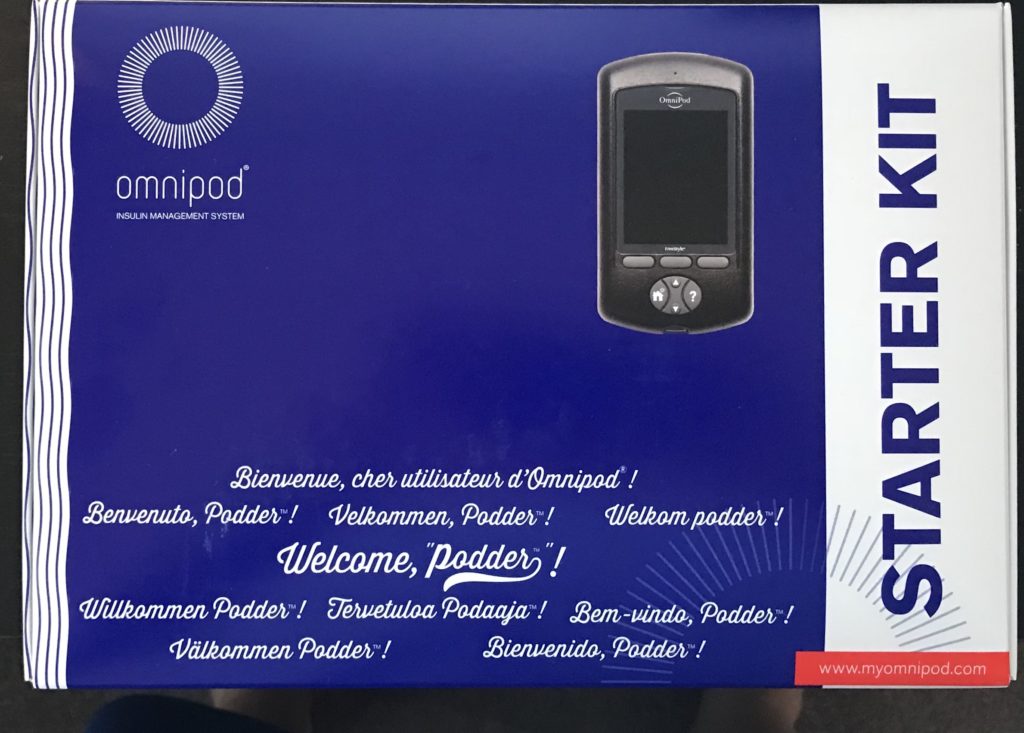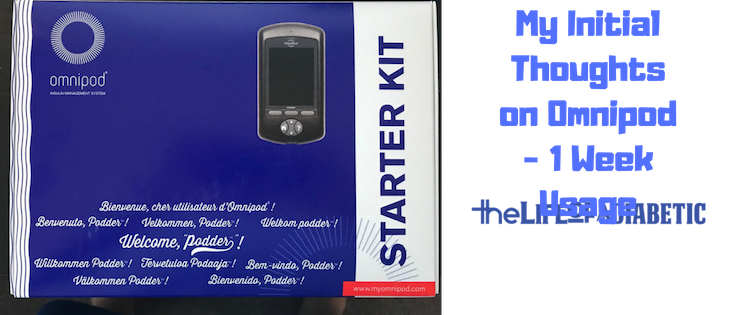I’ve been using my Omnipod for one week at this point and I wanted to collect and share my initial thoughts on Omnipod after one week of using.
Last Tuesday I had my endo appointment and afterwards had my Omnipod training in order for me to start using the Omnipod. I’ve had the Omnipod box at home for a little over a week and before I went to the appointment, I opened everything up and did a little set up video for you that you can see later this week over on my YouTube Channel.

Going into this endo appointment, I already knew that my A1C was going to be one of the highest it’s been since being diagnosed. How did I know this? Simple, my Dexcom 90 day average glucose report from Clarity told me. I have a full post later this week dedicated to just my A1C.
My weight was actually up 3 pounds since the last time I saw him in August. Not what I was hoping for. Everything else from the appointment went well. My blood pressure was perfect, as were all of my important labs. When I first came into the office, my heart rate was a bit high at 115, however, after the doctor did it again about 10 minutes later, it was down to about 85, which was better.
I do have a problem with high heart rates throughout the day, which is part of the major need to lose weight. Speaking of, I did a search on my site here, which I launched in 2009, and I’ve been talking about losing weight since about 2010 and all I’ve done since then is gain about 60 pounds. I’d say that’s not good.
Directly after my endo appointment, I was scheduled to meet with the nurse to do my Omnipod training.
When it comes to training for insulin pumps, I typically already know how 90% of it works. I don’t typically know the troubleshooting tricks and that’s what I like to learn in these trainings. However, when I go into the trainings, I act like I’ve never seen an insulin pump before and let the trainer do what they need to do. I do tell them that I am pretty advanced with technology and understand diabetes and was on a pump for 13 years. This way, they don’t waste either of our time talking about what a bolus is or temp basal, etc.
I understand it.
I’ve watched videos of people filling their Pods, but I never actually did it myself, so I asked for help to ensure that I was doing it the right way. I went through the setup process and once I was ready to put the Pod on, I decided to go on my left arm. Of course, when I put it on, I couldn’t see the viewing window, so couldn’t tell if the cannula was in properly, but I guess time would tell anyway.
My Unique Omnipod Insulin Management
Something that I have written about since I first started writing is the amount of insulin I use and how much of it I go through. I am on a 1:4 (insulin:carb) ratio and my average basal rate is about 2.5.
That’s a ton of insulin.
In order to not have to change out my pod every single day or every 36 hours, I recommended to my endo that I stay on Tresiba for my basal insulin and just utilize a 0.1 basal rate on my Omnipod. If I see that at certain times I may need an increased basal, then I do that. I don’t see a lot of lows, so the need to decrease my basal is not something that I utilize often.
However, if the Tresiba is already in my system and I’m low, then I correct the low, and if it becomes a pattern, I lower my Tresiba.
As of now, it’s worked pretty damn good.
Big Bolus Injections
I’ve still not cut out all horrible foods, so when I have eaten a high carb meal, I’ve injected insulin from an insulin pen for the extra dosage as opposed to taking the insulin from the Omnipod. I’ve decided to do this, so that I don’t dump too much insulin into the infusion site too fast.
Also, I’ve already had one Pod start to leak insulin because I dosed too much at one single time.
Lesson Learned on First Pod
The Pod that I inserted at the training session only lasted 24 hours. The next night at dinner time, I needed to take about 20 units of insulin. So, I dialed up the 20 units on my Omnipod PDM and hit the bolus button. The PDM started to do its thing and deliver the bolus.
Next thing you know, my arm felt a little wet and I smelled that awful smell of liquid gold, aka insulin.
I did the ole rub the site, then smell (did this far too often with Medtronic, which is one of the primary reasons I ultimately stopped using a pump), and I could smell it. Soon after, my wife said that she could smell it from where she was sitting.
I did the first thing that I always do when something happens, I went straight to Twitter. I wasn’t complaining, I was more looking for a solution, and luckily I found some.
One idea was to extend the bolus of anything over 3.0 units. So, that’s what I’ve been doing and it seems to have been working pretty well so far. I’ve had 2 other Pods on and neither has leaked since extended boluses out over 1 hour, on average.
I have my next follow up appointment already in a little over a week. My endo wanted me back in 2 weeks to look at Dexcom data to determine if we are going to stay with using Tresiba 100% for my basal insulin or if we are going to make it 75% of the basal insulin, plus 25% basal coming from the Omnipod.
Diabetes is all about testing, looking at the data, making an educated guess and testing all over again until you find the perfect management solution for yourself.
Overall, my initial thoughts on the Omnipod are great. I must say, I do hate the PDM. That is my only downside and flaw to the Omnipod system. The buttons are hard when I try to push them, which could be from it being so new and needing to break the buttons in.
Not being able to utilize a touchscreen for me is just brutal. Here’s the looking forward to the Omnipod Dash system.

Chris,
As a bigger guy what i did with my pump was take extended bolus’s almost every time. Particularly anything over 5u. I found that forcing large amount of insulin into a pump site was dangerous. My point is I completely understand. I hope you find pump zen.